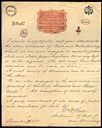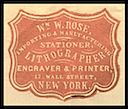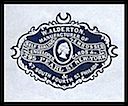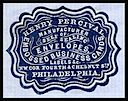Cameo Makers
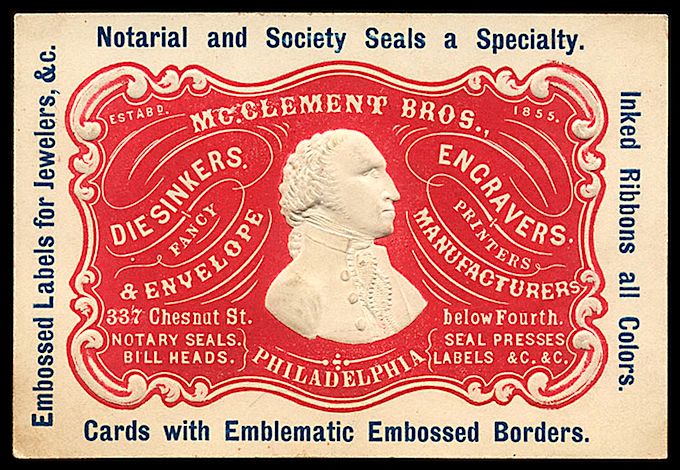
Embossed, colored “cameo” stamped impressions, in vogue from the 1850’s through the 1870’s, have become very popular with philatelic and ephemera collectors in recent decades. Cameos are particularly attractive, often combining fine graphics, carefully registered embossing, strong color and interesting typography in a tightly framed design. The die sinkers who created these advertising emblems were gifted artisans.
Cameos were produced from engraved brass metal dies, the designs executed in reverse. Generally created with gravers and other traditional hand engraving tools, cameo designs were sometimes additionally embellished using punches. When printed on good paper and strongly embossed through the use of male/female counterdies, cameos were always pleasing and sometimes spectacular. Indigo blue is the ink color most commonly seen, but examples exist in red, green, brown, black, purple, gold and other colors.
Without doubt, the die sinkers, engravers and printers of cameos produced cameos promoting their own businesses, but these are extremely elusive. Some cameo manufacturers advertised in business directories and newspapers; and we can assume that circulars, brochures, broadsides and sample books were distributed, though few have ever been found.
William Eaves of New York was the most prolific of the cameo engravers, active from 1851 into the late 1860’s. He covered a lot of ground geographically (examples are known from Canada to California) and executed commissions for a large variety of enterprises and professions. His body of work (540 different signed Eaves cameos found thus far) is truly wonderful, demonstrating meticulous attention to the graphic and decorative elements of his designs. And yet, only recently was a single example of his business card located, the only known example to date. In addition, an extremely rare advertising envelope for the early partnership of Eaves & Percival (1851-1852, successors to William Alderton) is in my collection.
The McClements of Philadelphia, the second largest cameo engraving business of the period (established in 1855 as A. & G. McClement and renamed in 1873 as McClement Brothers), produced three cameo business cards for their own use, the most spectacular of the two dates ca.1873, a heavily embossed card signed “McClement Bros.” (shown above). Another card, produced in blue, pictures two types of seal presses used in making embossed cameo images (this card is pictured, albeit in a poor black & white copy, in the Ephemera Society's monograph on cameos published in 1992). The third, known only in the format of an advertising envelope corner card in the collection of George K. Fox, is pictured in the gallery below.
Thomas B. Calvert, a successful and energetic entrepreneur in Philadelphia’s printing trade during the 1850’s (who later landed in Detroit where he produced a few cameos but soon concentrated instead on lithography) seems not to have ever produced a cameo card or other form of advertisement for himself or his firm while in Philadelphia (1852-1856). William Murphy in New York, a successful die sinker and envelope maker, seems also never to have made a cameo for himself, nor did numerous other lesser stars in the cameo universe.
Most cameo makers' cards, envelopes, invoices and letterheads were actually rather modest in design and straightforward in text. In the case of those makers who never signed their cameos, it is only through their own cameos—or the wording of their non-cameo billheads, etc.—that we know they were in the business of making cameos. This is true of Pilkinton in Baltimore, Rose in Montreal, Ott in Pittsburgh and a few others.
Thus far I have documented 5,500 different and distinct cameo designs, roughly 60% of which are unsigned. For the vast majority of them we have no way of knowing who made them. In some cases, attributions can be made based on commonly shared decorative elements and fonts consistently found on other signed and unsigned cameos, but even in those cases it's an educated guess.
In addition to cameo maker items in the José Rodriguez Cameo Collection, I have seen and keep notes on additional examples by George Nesbitt, Knox & Lang, Richard Paine, Smith & Hartmann, Robert Blum and a few others.
Over the last 25 years I have sought out as many examples as I could find and offer here a showing of many of my ”finds”.The gallery below presents a selection from the José Rodriguez Cameo Collection. Following those items will be other examples found in public sources such as auction catalogs and city business directories as well as examples found in private collections and presented here with the permission of the owners and credited to them. We hope to expand the gallery, and submissions from others will be welcomed.
Enjoy!
Clicking on a thumbnail image opens a larger image . . .
McClement Brothers
William Eaves
Stephen M. Ott
Samuel N. Dickinson
H. H. Halladay
Thomas L. Davis
W. J. Cochran
J. Walker & Son
E. A. Timme
Hedian & O'Brien
Hugh Scobie
Eaves & Percival
Maas, Percival & Maas
Maas, Percival & Mass
Charles Shields
Nathan Lane
George S. Harris
C. F. Hall
Edgar F. Baton
Samuel Raynor & Company
Samuel Raynor & Company
H. H. Shipley & Brother
Curtiss & White
J. B. Bannerman
Henry Rose
William W. Rose
William W. Rose
William Alderton
William Alderton
Henry Percival
Henry Percival
James E. Pilkinton
James E. Pilkinton
George A. Tuttle & Company
McClement Brothers
F. B. Smith & Hartmann

























